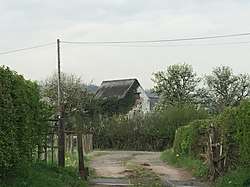Pen-y-clawdd Farmhouse, Raglan
| Pen-y-clawdd Farmhouse | |
|---|---|
 "a substantial 17th century house of the minor gentry" | |
| Type | Farmhouse |
| Location | Raglan, Monmouthshire |
| Coordinates | 51°46′14″N 2°48′49″W / 51.7706°N 2.8136°WCoordinates: 51°46′14″N 2°48′49″W / 51.7706°N 2.8136°W |
| Built | late 17th century |
| Architectural style(s) | Vernacular |
| Governing body | Privately owned |
Listed Building – Grade II* | |
| Official name: Pen-y-clawdd Farmhouse | |
| Designated | 19 November 1953 |
| Reference no. | 2099 |
Listed Building – Grade II | |
| Official name: Barn at Pen-y-clawdd Farm | |
| Designated | 31 January 2001 |
| Reference no. | 24721 |
 Location of Pen-y-clawdd Farmhouse in Monmouthshire | |
Pen-y-clawdd Farmhouse, Raglan, Monmouthshire is a gentry house dating from the early 17th century. Owned by the Bradburys, High Sheriffs of Monmouthshire, and later by the Williams family and then the Prichards of Penallt, it remains a privately-owned farmhouse. The building is Grade II* listed.
History
Sir Cyril Fox and Lord Raglan, in their three-volume guide Monmouthshire Houses, give building dates for the house from 1600 to 1680.[1] Cadw suggests a longer construction period, from the mid-16th to the early 18th centuries.[2] The owners in the 18th century were the Bradburys, High Sheriffs of Monmouthshire, "whose extravagant living ruined the estate".[2] During the Bradbury's tenure, the Swearing Room in the house was used as a courtroom.[2] The farm subsequently had a number of owners from the Monmouthshire gentry and remains the working farmhouse of a privately-owned farm.
Architecture and description
The architectural historian John Newman describes Pen-y-clawdd as "a well-preserved farmhouse demonstrating the typical improvements of a family going up in the world".[3] The building is of whitewashed rubble and constructed to a height of two storeys with attics.[2] The interior includes the panelled Swearing Room, and an upper chamber with a fireplace decorated with Delft tiles depicting Biblical scenes.[3]The farmhouse has a Grade II* listing, its listing describing it as "a substantial 17th century house of the minor gentry". [2] The farm's large, red-brick and timber barn has a separate Grade II listing.[4] Fox and Raglan give a date for the barn of the late 17th century.[5]
Notes
- ↑ Fox & Raglan 1994, p. 156.
- 1 2 3 4 5 "Listed Buildings – Full Report – HeritageBill Cadw Assets – Reports". cadwpublic-api.azurewebsites.net.
- 1 2 Newman 2000, pp. 468–469.
- ↑ "Listed Buildings – Full Report – HeritageBill Cadw Assets – Reports". cadwpublic-api.azurewebsites.net.
- ↑ Fox & Raglan 1994, p. 123.
References
- Fox, Cyril; Raglan, Lord (1994). Renaissance Houses. Monmouthshire Houses. 3. Cardiff: Merton Priory Press Ltd & The National Museum of Wales. ISBN 1-898937-00-1.
- Newman, John (2000). Gwent/Monmouthshire. The Buildings of Wales. London: Penguin. ISBN 0-14-071053-1.